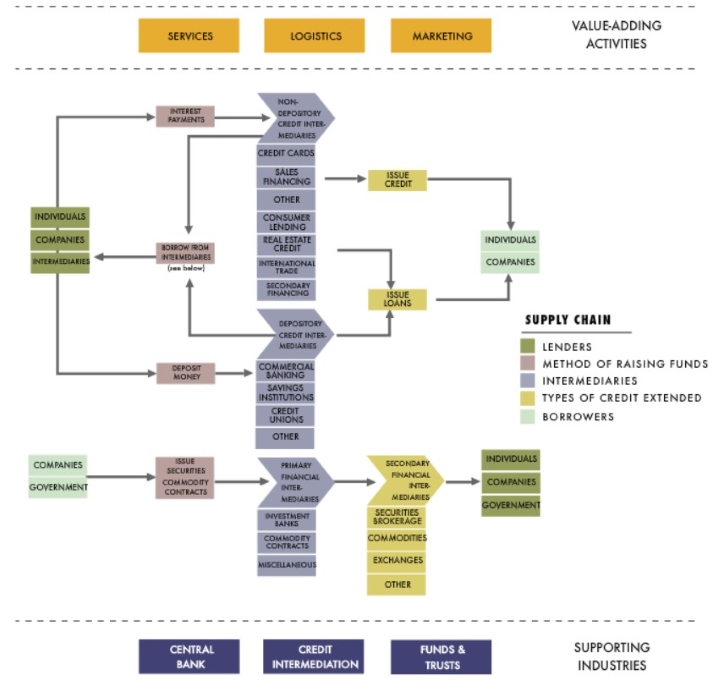Value Chain (2012)
Banks & Finance Value Chain 2012

Value Chain Description
The banking and finance value chain is unique because it is based entirely around the production of services. In this industry, the "raw materials" are lenders and borrowers (private/public firms and individuals) that appear at both the beginning and the end of the chain. The products provided by this industry are divided between credit intermediaries (both depository and non-depository) and financial intermediaries. North Carolina is strongest in depository credit intermediaries, most specifically, in commercial banks. These institutions primarily collect funds through deposits and lend funds by issuing loans. These institutions in general capture high levels of value, albeit on average not as high as other institutions like investment banks. Importantly though, the fine line between the functions of commercial banks and investment banks is continually becoming thinner, and in many cases in North Carolina, commercial banks also conduct investment banking services. This trend is serving to improve the competitiveness of North Carolina firms within the wider banking GVC. Moreover, the banking transaction does not represent the end of the relationship between the lender and the borrower. Banking services generally entail the establishment of a relationship between the two and as a result, firms perform a variety of activities before and after the sale of a product, which allow for multiple streams of value capture.
Introduction to NCGE Value Chains
Value Chains on the North Carolina in the Global Economy (NCGE)
What is a value chain?
A value chain describes the full range of activities that firms and workers carry out to bring a product or service from its conception to its end use and beyond. This includes activities such as design, production, marketing, distribution and support to the final consumer. The activities that comprise a value chain can be contained within a single firm or divided among different firms and can be contained within a single geographical location or spread over wider areas. For additional background on the origins and research associated with this concept, see the Duke-hosted website, www.globalvaluechains.org.
Value Chain Dimensions
Each industry value chain is composed of three dimensions that work together to produce final products and services for the market. These include:
Value-Added Activities: Value is created in products and services via a series of six steps: research & development, design, production, logistics, marketing and services. Each of these varies in importance based on the industry. In the visual depictions, the top line is composed of the most important value-adding activities for each industry. When you hover the cursor over any “value-adding activities” box information on the activity and its connection to the supply chain appear.
Supply Chain: Each industry has an input-output process that begins with raw materials and continues through the making of components and final products, and finally to distribution and sales. In the value chain visuals, the supply chain is broken into five colors; each representing of the basic stages. When you place your cursor over these boxes, a description of each activity appears along with statistics (based on NAICS codes) on the number of firms, employees and average annual wages per employee in North Carolina (see the Website Overview for information on NAICS codes). The arrows represent the main stages and the boxes listed below represent specific types of products, processes or markets.
Supporting Industries: The supporting environment includes the entities that support and influence actors in the supply chain such as trade and professional associations, government agencies, testing and training facilities, community colleges and universities as well as material and machinery providers. The entities present in North Carolina are located along the bottom row of the visual. When you hover the mouse over these boxes the supply chain stages impacted by the supporting industry is highlighted and statistics or descriptive text is displayed when available.
